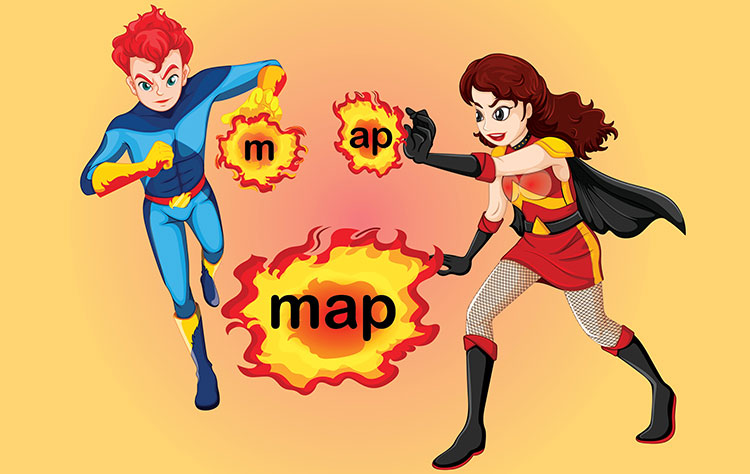F4: Word Maker, Part 1
1. Overview
Blend the first sound (phoneme) together with the remainder of a spoken one-syllable word, but with no picture clues. This is the same activity as What’s My Word? Part 1 (F1), but with no picture cards to provide a visual clue.
/mmm/ • • /ap/ … WordMakers, make that word!
2. Materials & Preparation
- Script
- word list
- sound cards — these are the same as the cards from What’s My Word? Part 1 (F1)
Adult: Remember, this is how the /mmm/ sound looks when it is written down. Listen carefully: /mmmmm/. What’s the sound? Child: /mmm/. Adult: Yes, /mmm/. Now touch under it and say the sound with me. Get ready: [Touch under the card and say the sound in unison with the child.] Adult and Child: /mmm/. Adult: Once more, by yourself. Get ready: Child: [while touching card underneath letter] /mmm/. Adult: Good job saying the /mmm/ sound!NOTE: When working with a stop sound (a.k.a. “quick and quiet” sound), like /b/, you may need to say the sound a few times to make sure the child hears you, like “/b/ /b/ /b/.” But when the child responds, she should just say the sound once. ↑ Top
3. Activity
Video: How to play Word Maker, Parts 1-3
Pick a starting sound (for example, /mmm/), and refer to the word list for suggested words starting with that sound. You will say the word to the child in two parts, separated by a one-second pause (written as • •), and he must combine them into a whole word.
Adult: I’m going to say this sound [point to the sound card] and some more sounds. You put the sounds together and tell me what word they make. Listen: [point to card] /mmm/ • • /ap/. Again: /mmm/ • • /ap/. What’s my word? Child: Map! Adult: Yes, /mmm/ • • /ap/ is map. Good job making the word!Our word list has up to 30 words for each starting sound. Say the words for that starting sound, emphasize the starting sound, and have your child repeat each word back to you. Then go back and repeat any that the child struggled with. Pick five words from the list for that starting sound. Say each word in two parts. Have the child make the word from its parts, and then have him use the word in a sentence. This is a great way to review the skill of Creating Sentences. Keep returning to this activity until the child has covered all the starting sounds. NOTE: Have the child point under the letter on the sound card each time he combines your two spoken sound parts and says the whole word starting with that sound. ↑ Top
4. Schedule
You will do this activity with your child numerous times in order to familiarize the child with all the different consonant starting sounds. Introduce one new letter sound a day, according to the schedule in the table below.| Day | Review | Add |
|---|---|---|
| 1 | — | m |
| 2 | m | s |
| 3 | m, s | t |
| 4 | m, s, t | v |
| 5 | m, s, t, v | — |
5. Confidence Builder
If the child struggles, try putting a shorter pause (written with bullet points) between the starting sound and the rest of the word as you say them.Adult: Listen again: /b/ • • • /ake/. /b/ • • /ake/. /b/ • /ake/. What’s the word?The “quick and quiet” letter sounds (b, c, d, g, h, j, k, p, t) are harder for a child to hear than the continuant consonants (f, l, m, n, r, s, v, w). The quick and quiet sounds may need to be repeated, as in /b/ /b/ /b/ [pause] /ake/, for your child to really hear what you’re saying. ↑ Top
6. Extension
Say a word you presented earlier in the lesson to the child. Have the child divide it into two parts (for example, /mmm/ and /ap/). This is essentially a reverse of the activity above. It requires the child to analyze and segment the word instead of blending it. ↑ Top7. Small Groups (2-5 children)
Lesson Objective: Using a consonant letter card but no picture aids, children will hear the letter’s phoneme followed by the rest of a spoken, one-syllable word (onset-rime) and blend the two parts together into one spoken word. GELDS (Georgia Early Learning & Development Standards): CLL6.4f Georgia Standards of Excellence: ELAGSEKRF2.c Common Core State Standards: CCSS.ELA-LITERACY.RF.K.2.C Additional Materials:- two crayons (one red, one green) for each child
Leave a Reply
